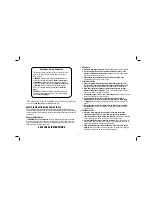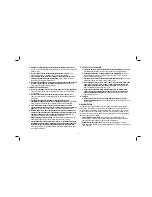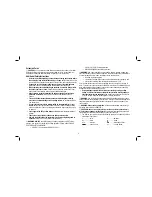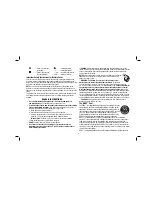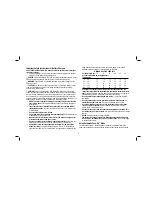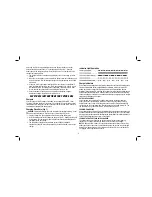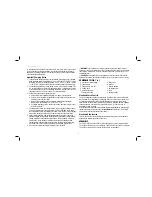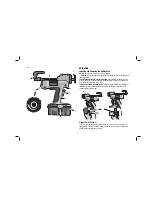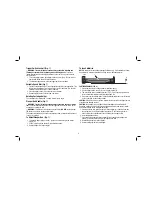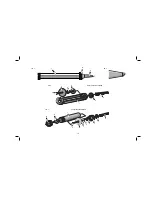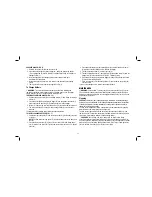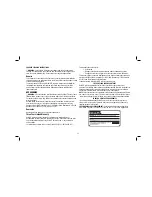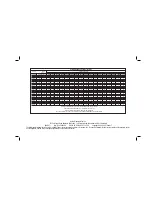
6
up weekly or after 10 charge/discharge cycles or whenever the pack no longer
delivers the same amount of work. To use the Automatic Tune-Up™, place the
battery pack in the charger and leave it for at least 8 hours. The charger will cycle
through the following modes.
1. The red light will blink continuously indicating that the 1-hour charge cycle has
started.
2. When the 1-hour charge cycle is complete, the light will stay on continuously and
will no longer blink. This indicates that the pack is fully charged and can be used
at this time.
3. If the pack is left in the charger after the initial 1-hour charge, the charger will
begin the Automatic Tune-Up mode. This mode continues up to 8 hours or until
the individual cells in the battery pack are equalized. The battery pack is ready
for use and can be removed at any time during the Tune-Up mode.
4. Once the Automatic Tune Up mode is complete, the charger will begin a
maintenance charge; the red indicator will remain lit.
SAVE THESE INSTRUCTIONS FOR FUTURE USE
Chargers
Your tool uses a D
E
WALT charger. Your battery can be charged in D
E
WALT 1 Hour
Chargers, 15 Minute Chargers or Vehicular 12 Volt Charger. Be sure to read all safety
instructions before using your charger. Consult the chart at the end of this manual for
compatibility of chargers and battery packs.
Charging Procedure (Fig. 1)
DANGER:
Electrocution Hazard. 230 volts are present at charging terminals. Do not
probe with conductive objects. Electric shock or electrocution may result.
1. Plug the charger into an appropriate outlet before inserting battery pack.
2. Insert the battery pack into the charger, as shown in Figure 1, making sure the pack
is fully seated. The red (charging) light will blink continuously indicating that the
charging process has started.
3. The completion of charge will be indicated by the red light remaining ON
continuously. The pack is fully charged and may be used at this time or left in the
charger.
Indicator Light Operation
Charge Indicators
Some chargers are designed to detect certain problems that can arise with battery packs.
Problems are indicated by the red light flashing at a fast rate. If this occurs, reinsert
battery pack into the charger. If the problem persists, try a different battery pack to
determine if the charger is OK. If the new pack charges correctly, then the original pack is
defective and should be returned to a service center or other collection site for recycling.
If the new battery pack elicits the same trouble indication as the original, have the charger
tested at an authorized service center.
HOT/COLD PACK DELAY
Some chargers have a Hot/Cold Pack Delay feature: when the charger detects a
battery that is hot, it automatically starts a Hot Pack Delay, suspending charging
until the battery has cooled. After the battery has cooled, the charger automatically
switches to the Pack Charging mode. This feature ensures maximum battery life. The
red light flashes long, then short while in the Hot Pack Delay mode.
PROBLEM POWER LINE
Some chargers have a Problem Power Line indicator. When the charger is used with some
portable power sources such as generators or sources that convert DC to AC, the charger
may temporarily suspend operation, flashing the red light with two fast blinks followed by a
pause. This indicates the power source is out of limits.
LEAVING THE BATTERY PACK IN THE CHARGER
The charger and battery pack can be left connected with the red light glowing
indefinitely. The charger will keep the battery pack fresh and fully charged.
NOTE:
A battery pack will slowly lose its charge when kept out of the charger. If the
battery pack has not been kept on maintenance charge, it may need to be recharged
before use. A battery pack may also slowly lose its charge if left in a charger that is
not plugged into an appropriate AC source.
Summary of Contents for DC545-XE
Page 1: ...DC545 XE DC546 XE DC547 XE HEAVY DUTY 18V CORDLESS ADHESIVE GUN INSTRUCTION MANUAL ...
Page 2: ......
Page 15: ...13 ...



